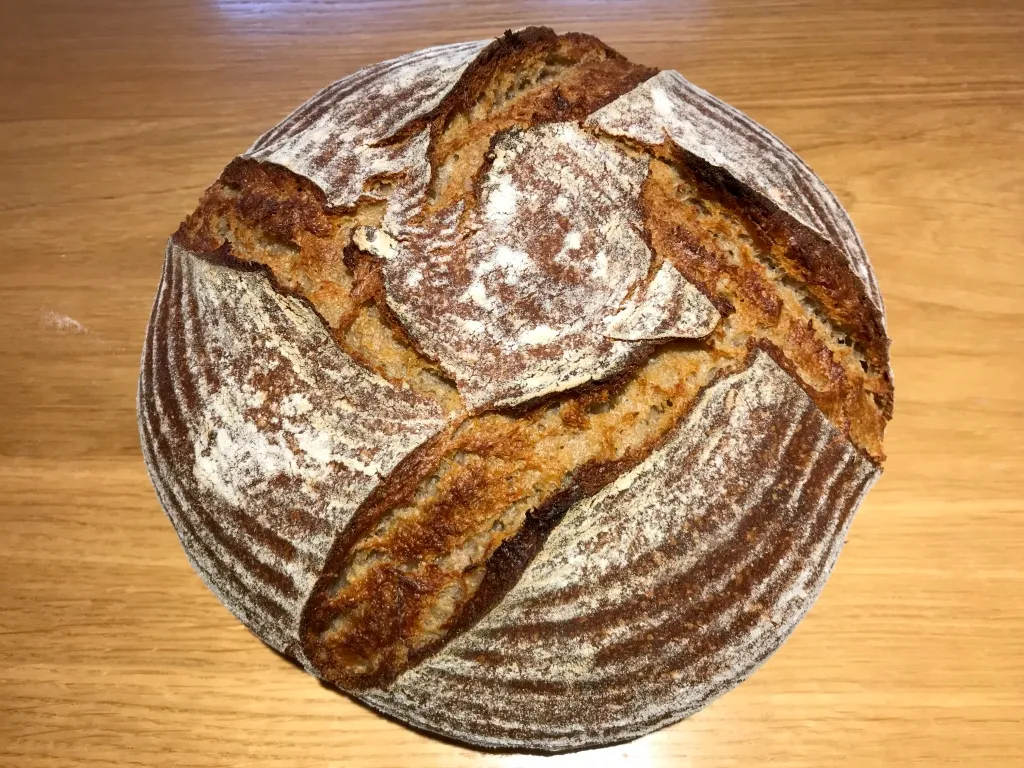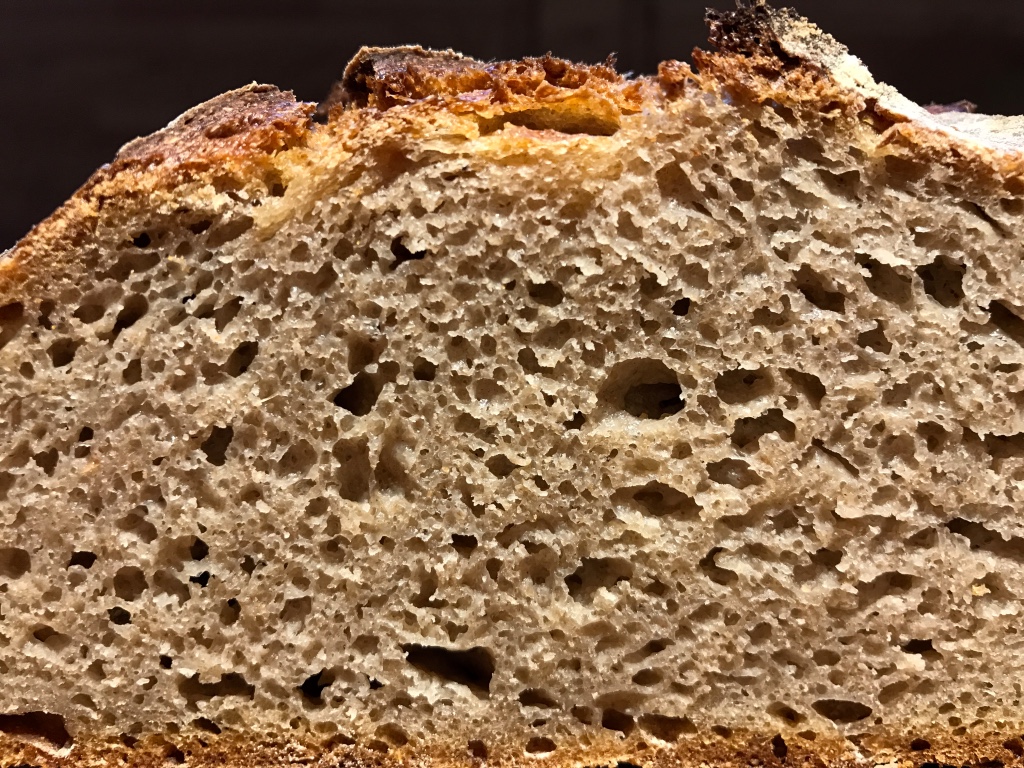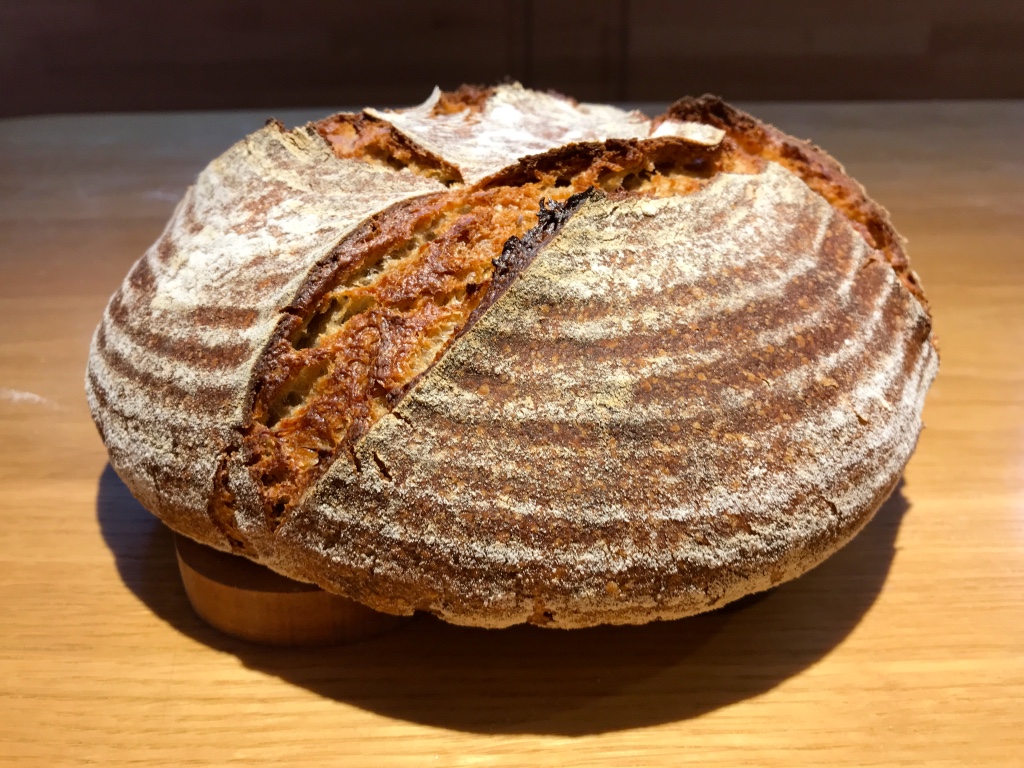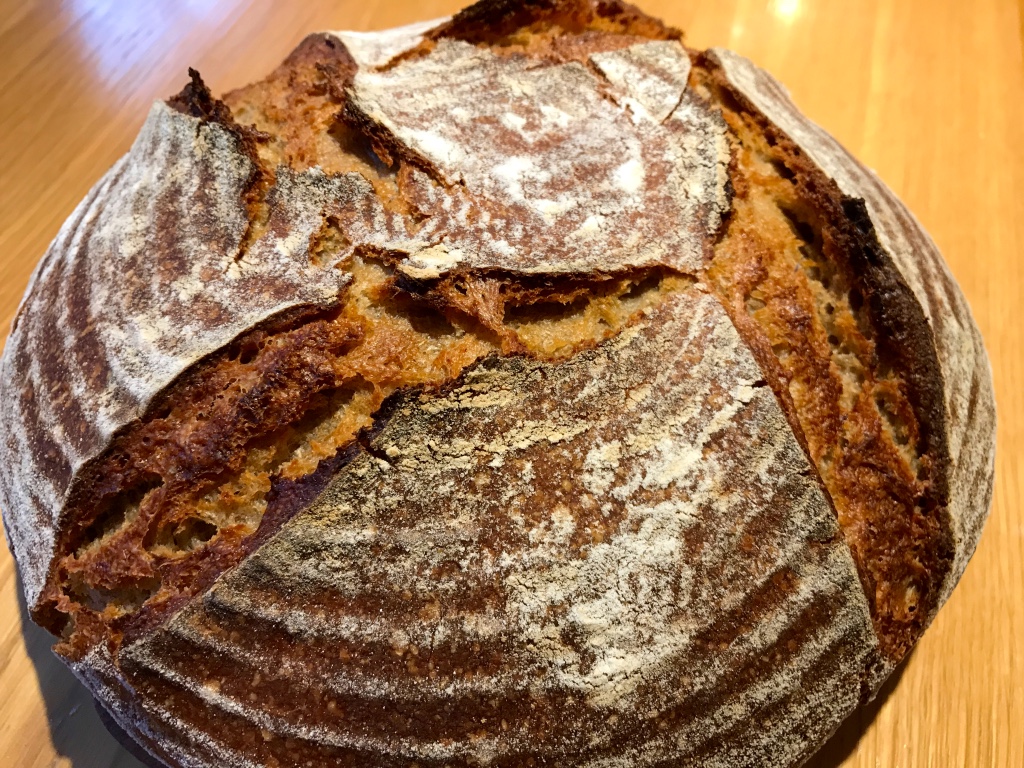
This is a very tasty bread with 30% of barley flour, 30% of rye flour and 40% strong bread flour.
Procedure:
1.) Prepare 20% of leaven at 100% hydration (could be with white flour or rye flour)
2.) Mix all ingredients flour+water+leaven +2% of salt (no autolyse) and develop the gluten right away after you mix on low speed for about 3 minutes.
3.) Do series of S&F in 30-45 minutes intervals.
4.) The bread on the picture was cold retarded for 20 hours.
Bake as you normally bake your breads, nothibg special required.



Happy baking,
Joze
- joc1954's Blog
- Log in or register to post comments
Barley and rye? I know even just a little barley can make a big difference in the handling and crumb yet you've turned out a beautiful loaf with 30% and rye to-boot!
Beautiful and such a good crumb.
Thanks Abe!
One of the secrets is that there is no autolyse which is by my opinion not needed for this kind of bread. Actually the autolyse in this case would just add more extensibility to the dough which I don't need. So during the second part of the mixing process the gluten is developed (as much as it could be) which I developed further through S&F every 45 minutes in average. I let the dough rise for about 20-30% during the bulk fermentation (about 3 hours long at 27 degrees). Then I did a very loose preshape and final shape. The dough was not very strong so there was almost impossible to build in the surface tension. The retarded cold final proof added a lot to the relatively opened crumb.
Happy baking Abe!
Joze
I have always wanted to try my hands at a multigrain sourdough but many recipes seems to produce a rather dense loaf. I love a moist and chewy crumb and your recipe seems to be what I am looking for! Sadly, barley flour is not something I have access to easily so do you have any suggestions on other whole grain flour substitutes?
Anyway, I have to try out this version if I spot a bag of barley flour elsewhere! Thanks for the amazing recipe!
Thanks Elsie lu!
I hardly suggest you a multigrain mixture as I don't know your preferences and what kind of flours are accessible to you.
I will throw some mixtures which I found extremely tasty in past and bake frequently:
1.) 10% whole-grain spelt, 10% rye (could be whole-grain), rest bread flour
2.) 40% whole-grain kamut, 10% whole-grain spelt, 50% bread flour
3.) 50% rye , 50% strong bread flour
4.) 20% semola, 20% kamut whole-grain, 20% einkorn, 40% strong bread flour
Most of these combinations have hydrations between 73-78%, this depends very much on the flour. All above combinations will give you a moist and chewy crumb. You can increase the percentages of these flours and decrease the percentage of strong bread flour if you find that you would like to get even more tasty crumb.
Happy baking,
Joze
Wow, I never thought it is possible to achieve a moist crumb with 50% rye! Thanks for the suggestion! Do you mean white rye when u mention it?
Wow, I'm impressed! I make a sourdough with barley and spelt flour, and the dough is so soft I have to bake it on the Italian (perforated) bread pans to help it keep it's shape. I'd like to try this one, for sure.
For how long was it bulk fermented at room temperature, before cold retarding (I'm assuming you retarded the bulk ferment, not the shaped proof)? I tend to overferment doughs with this much non-wheat flour. I need to learn how to improve that.
Thanks Lazy Loafer for your nice opinion.
This was bulk fermented for about 3.5 - 4 hours. I never look at the wall clock but monitor the dough. After bulk fermentation I did a preshape and final shaping and then retarded the loaf for 20 hours. Usually I use this kind of approach. Very rarely I retard before shaping.
This dough is a bit tricky due to relatively high percentage of rye and barley flour so the typical signs of the dough are somehow not so clearly visible. I left it to rise about 20-30% during the bulk ferment and then continued with shaping and immediate retard. The other trick I used here is no autolyse.
Regarding your spelt and barley sourdough I would suggest you to skip completely the autolyse as spelt has already very pronounced extensibility of the dough due to the different properties of spelt gluten. Spelt also ferments faster as wheat so you must really watch the dough in order not to be to late. A bit less of water could also help to get more elastic dough. Will try a combination of spelt and barley in a short time as I still have just enough barley flour for such experiment.
Happy baking,
Joze
Lazy Loafer, I did my homework and tried 30% barley 70% white spelt bread with over 70% hydration and it worked just fine. I could even play with scoring as the dough was stiff enough. I just mixed all ingredients at once (no autolyse, no "fermentolyse") and then develop the gluten on my KA mixer so I got very coherent dough. The rest of the procedure was the same as with my first loaf. The result is seen on the picture.
Happy baking!
Joze
Thank you so much for trying that combination, Joze! I will follow your advice and see what happens. I don't have white spelt, only stone ground whole spelt, but I could try sifting some to make high extraction spelt and see how that goes. Or part whole spelt, part bread flour. No autolyse; short bulk. :)
Just a warning - sifting of whole-grain spelt flour will give you a high extraction flour which will still retain a lot of properties of a whole-grain spelt flour, at least that is my experience. It is "better" but far away from white spelt. However, the properties of high extraction wheat flour are much better than those of the spelt flour. Therefore my advice would be to add maybe 20-30% of wheat flour to compensate for that. Never tried the combination of barley and high extraction spelt flour so this is just my guessing from experiences when I was using high extraction spelt flour. I found huge differences in the baking quality of different spelt flours and also grain so it could be that your spelt flour is quite different - better or worse :-)
But I will try it once as I have a lot of barley and spelt in grain just to see how accurate were my predictions.
Regarding the rest - try your existing combination without autolyse and by adding the salt together with the rest of ingredients and compare that with what you get now.
Definitely I will now bake more with barley as my daughter and her children are very happy with this kind of bread (combination with wheat or wheat and rye) due to the moister crumb and excellent taste. Personally I prefer combination with wheat but have to wait to get their feedback for the combination with spelt.
Happy baking Lazy Loafer!
Joze
you recently displayed here this past week or two have been fabulous. And congratulations on your recent, and now seemingly annual, prize winning entries!
I came into a bag of barley flour that has been sitting in my pantry undisturbed since being gifted it by a certain someone on TFL. But now I think I know its future disposition. And this will be my first foray in introducing barley flour into a bread. Hmm, might just wind up looking like a baguette. Ya think?
Just for the record (as well as some accuracy) when you state "Prepare 20% of leaven at 100% hydration" I understand that to mean that the 20% is the percentage of pre-fermented flour in the levain, rather than 20% of the final mix is the levain (F+W). Or... Also, would you say that this was ~75% hydration dough? thanks.
Been laying low for the past few weeks while out of town, so didn't comment earlier on the other wonderful wares you've been posting. Really superb across the board.
alan
First thanks Alan for your so nice opinion. I think you are way too kind.
Second, the bread assessments are for mi a bit of stimulus for making something special and the last one was just the right one to push myself in something new - the braided bread. Honestly speaking, I was really lucky to achieve such good result with the second braided bread in my life. I didn't expect it. I always admired this kind of breads and wanted to learn how to make them so this assessment and display was a perfect occasion to fulfil these wishes. Most of the knowledge I got from Jeffrey Hamelman book "Bread" - theory was there but the practice had to gain. Of course I had a lot of experience with dough which was quite beneficial, but not with braiding and how braided multi tier bread will behave during the proofing and baking. So here the luck was my best friend. Now I decided to make this kind of bread for birthday gifts what will give me more experience.
So let us talk now about the barley bread - 20% is baker's percentage for the leaven - as it is at 100% hydration this means that the flour used for leaven preparation is only 10% of all flour. I must apologise as I haven't written down the whole table with all percentages and weights which would help you to decode this easily.
The overall hydration (main dough + prefermented part) was roughly about 75% as I was adjusting the hydration while mixing the dough. Initially I started with 70% hydration for the main dough only and added some more water later on as I found the dough a bit too stiff. So if you just leave the initial hydration of main dough at 70% it will probably be just fine. It was the first time I did this kind of bread so I was acting only according to my feelings and not experience. But I was luck as I was quite happy with the result.
I hope this will help you. I would love to see this bread shaped as baguette.
Happy baking!
Joze